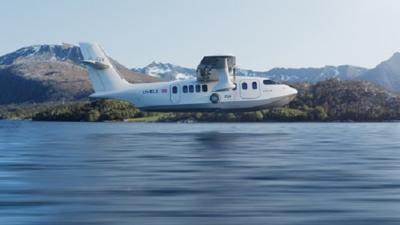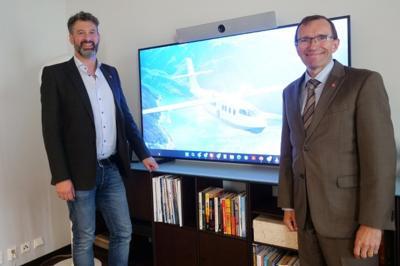Monies to Hasten Development of Noemi Electric Seaplane
Following receipt of an $8 million-plus grant from Enova SF, Norway’s Ministry of Climate and Environment, the Elfly Group is to forge ahead with the production of a full-scale prototype of its all-electric commercial seaplane.

Dubbed Noemi (No-Emissions), the aircraft instantiates its designers’ ambition to contemporaneously improve Norway’s air-transport infrastructure and safeguard its unique and spectacular natural vistas and indigenous flora and fauna.
The award underscores the Norwegian Government’s aspirations to transition to a low emission society and make domestic flying emission-free by 2040. Elfly Group will support the governmental goal by reducing CO2 emissions—by dint of its Noemi platform—by an approximately three-million-tons worldwide by 2050.
Having been awarded more than $10-million in soft funding combined with matched funding from early investors headed by the company’s founder and CEO Eric Lithun, Elfly will next pursue key developmental milestones at the company’s Jarlsberg, Norway design and production facility.
Mr. Lithun stated: “Our team is delighted by the recognition and endorsement of Noemi, our all-electric seaplane.” Lithun thanked Enova and Espen Barth Eide, Norway’s Minister of Climate and Environment, for “recognizing our business case and aligning with our program as a viable solution.”
Elfly’s amphibious Noemi program, backed by Norway’s Innovation Research Foundation, SINTEF, is being engineered for flexible regional mobility. Specifically, the design of the inchoate aircraft’s fuselage was informed by maritime architectures conducive to its lifting-off from bodies of water with minimal expenditure of its finite electrical energy stores. The non-passenger-carrying Noemi prototype is being readied for a 2025 first flight. The aircraft’s designers aspire to see the machine’s production iteration manage a 135-knot maximum speed over a range of 107-nautical-miles.
The Noemi seaplane’s unpressurized cabin will accommodate nine to 13 occupants and feature large windows and a sizable cargo door. The aircraft will be motivated, ostensibly, by a pair of electrical motors with a combined output of one-megawatt (1MW). Electrical power will be provided by lithium batteries designed by U.S.-based Electric Power Systems (EPS). Elfly has yet to designate an engine supplier.

Elfly seeks to operate a total of 15 Noemi aircraft on its own Air Operator Certificate (AOC). The company intends to focus, initially, on the Norwegian market by connecting communities in the vicinities of the country’s innumerable fjords and lakes.
Thereafter, Elfly intends to explore opportunities in other short-hop markets, availing itself of the fact that eighty-percent of the world’s human population lives in close proximity to water.
Mr. Lithun concluded: “Many Norwegians live by fjords and lakes, but need access to hospitals, big cities, and connections to the world. Our fjords can be turned into potential (floating) airports without destroying nature. While the country is home to 5.5-million people, we consume ten-times more travel—the equivalent of a population of 55-million. First and foremost is the need for sustainable travel, which we believe will also enable many economic opportunities for coastal communities.”
 ANN's Daily Aero-Linx (05.06.25)
ANN's Daily Aero-Linx (05.06.25) ANN's Daily Aero-Term (05.06.25): Ultrahigh Frequency (UHF)
ANN's Daily Aero-Term (05.06.25): Ultrahigh Frequency (UHF) ANN FAQ: Q&A 101
ANN FAQ: Q&A 101 Classic Aero-TV: Virtual Reality Painting--PPG Leverages Technology for Training
Classic Aero-TV: Virtual Reality Painting--PPG Leverages Technology for Training Airborne 05.02.25: Joby Crewed Milestone, Diamond Club, Canadian Pilot Insurance
Airborne 05.02.25: Joby Crewed Milestone, Diamond Club, Canadian Pilot Insurance




